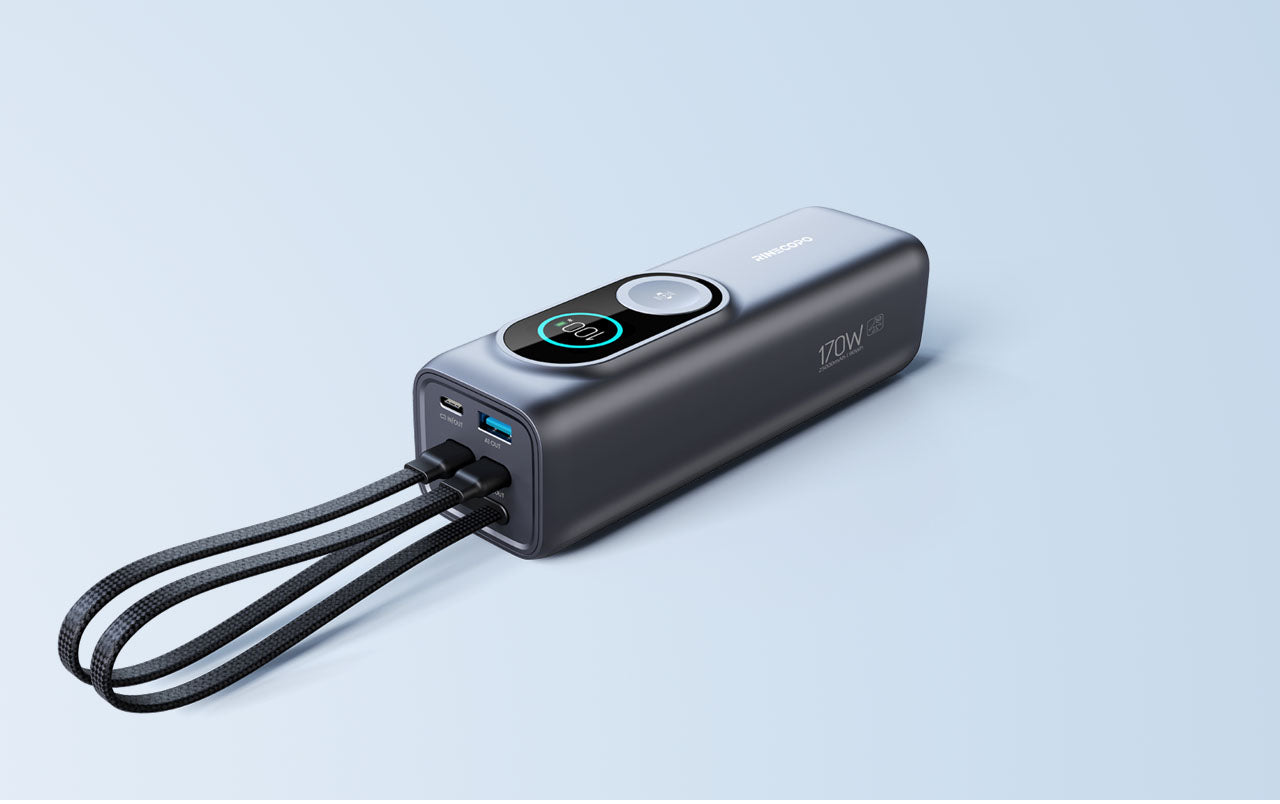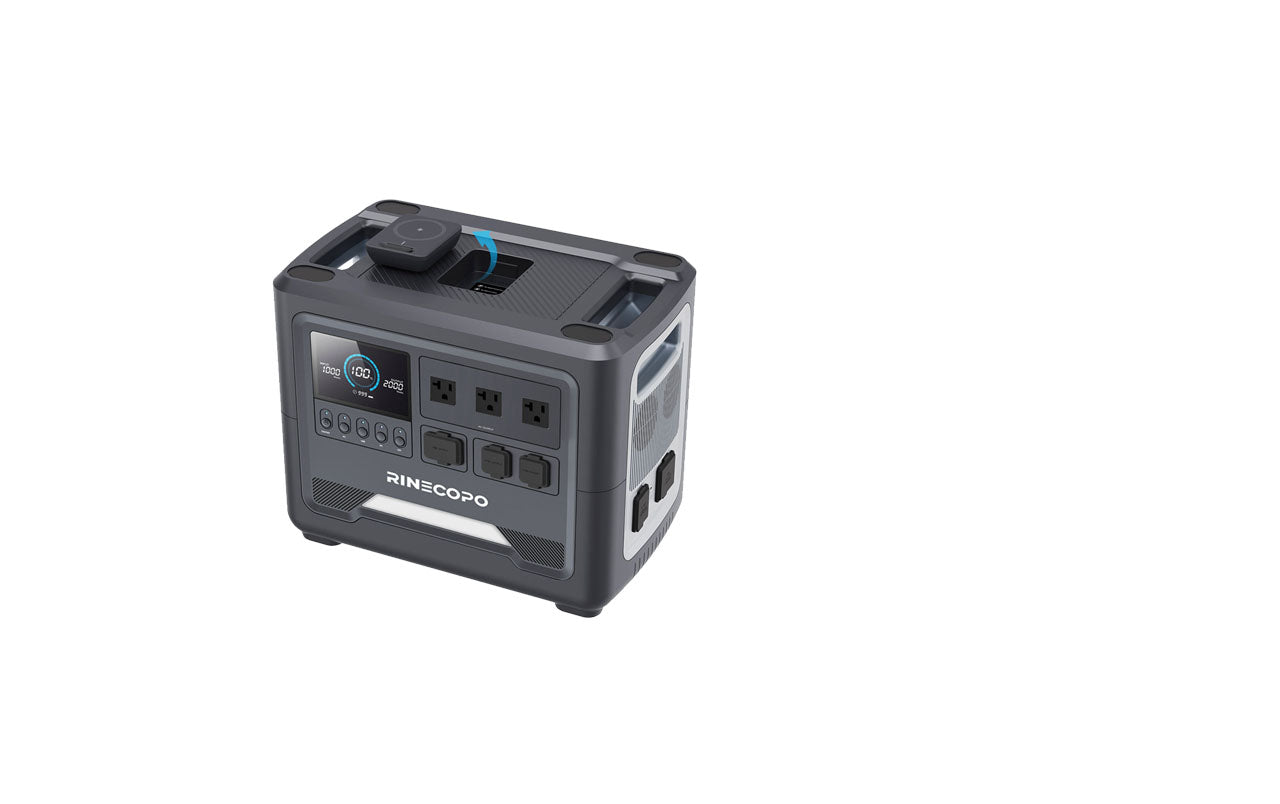
Multi-Port USB Chargers
A multi-port USB charger is an electronic device equipped with multiple USB ports, allowing you to charge several devices at once—phones, tablets, laptops, and more. By consolidating multiple charging interfaces into one device, it makes charging more efficient and organized, perfect for travel, work, or home use.
With laptops, smartphones, and tablets demanding faster charging, the need for multi-port chargers has steadily increased. Users want a charger that’s compatible with all their devices, whether at home, in the office, or on the go.
RINECOPO multi-device chargers typically include both USB-A and USB-C ports. Their compact design lets you charge multiple devices at once, frees up outlet space, and eliminates plug conflicts, making charging a hassle-free experience.
Pro Tip: When traveling, bringing a single multi-port charger allows you to charge your phone, tablet, and camera simultaneously—no need for multiple charging cables.
How Multi-Device Chargers Work
Power distribution in multi-port chargers refers to how the total available power is allocated among the connected devices.
The maximum power output across all ports is called the total power limit, which can be found in the technical manual.
No matter the distribution method, total output should never exceed the charger’s rated capacity. Keeping this in mind prevents underperformance or overload when charging multiple devices simultaneously.
Scenario: Charging both a laptop and phone at your desk might slow down your phone’s charging speed if the charger’s power is limited, preventing your laptop from charging at full speed.
Power Distribution Methods
● Static Distribution
Basic multi-port chargers have fixed output for each port, regardless of how many devices are connected.
● Priority Distribution
Some chargers allocate power based on port priority. For example, USB-C ports may get higher output while other ports share the remaining power.
● Smart Distribution
Smart chargers dynamically allocate power based on the needs of connected devices. RINECOPO’s intelligent technology calculates each device’s power requirements and distributes total output efficiently, ensuring every device gets enough power while maximizing efficiency and maintaining safety.
Pro Tip: At home, charging multiple devices at once with smart distribution ensures each device charges quickly without leaving one device “lagging behind.”
Common Power Distribution Issues
-
Reduced Charging Performance
A 65W charger may distribute 45W to one device and 20W to another when charging two devices simultaneously, slowing down the overall charging speed. -
Device Incompatibility
Not all ports support protocols like Power Delivery or Quick Charge, which can slow down charging. -
Overload
Connecting too many high-demand devices may exceed the charger’s total output, slowing or even stopping charging. -
Cable Issues
Low-quality or incompatible cables can affect power distribution, even if the charger supports fast charging.
Additionally, inserting unused cables into empty ports can trigger power redistribution, impacting charging stability.
Scenario: During a family gathering or at the office, if multiple people plug in cables without devices, smart distribution might slow down other devices’ charging.
Choosing the Right Charger Based on Power Needs
-
Check Total Wattage
Make sure the charger’s total output can support all your devices. For example, a 100W or higher charger is recommended for charging a tablet, phone, and laptop at the same time. -
Know Your Needs
If you mainly need maximum USB-C output, choose a charger with a single USB-C port or one that supports fully dynamic distribution. -
Choose RINECOPO Chargers
RINECOPO chargers are compact and highly efficient, handling dynamic power allocation while keeping temperatures low.
Pro Tip: For frequent travelers, RINECOPO chargers are lightweight and capable of fast charging multiple devices at once—perfect for trips.
Tips to Avoid Power Distribution Issues
-
Use high-quality USB-C or USB charging cables
-
Avoid plugging in cables when devices aren’t connected
-
Check the manual for total wattage before use
-
Know each device’s power requirements
-
Disconnect the charger when not in use
Scenario: At night, unplugging unused cables while charging your phone and earbuds helps your phone charge faster.
Recommended RINECOPO 140W 4-Port Laptop Charger
If you’re looking for a charger that can efficiently power multiple devices at once, the RINECOPO 140W 4-Port Laptop Charger is ideal. It features three high-speed USB-C ports with up to 100W output each and one standard USB-A ports, providing a total output of 140W, allowing you to charge a laptop, tablet, and phone simultaneously without switching devices.
Its compact size (approx. 120mm x 65mm x 30mm) and light weight (around 280g) make it easy to carry, whether on your desk or on the go, keeping your workspace organized. Built-in intelligent power management automatically adjusts each port’s output, maintaining ±5% output stability for fast and safe charging.
Multiple safety protections, including overheat, overload, and short-circuit prevention, ensure safe charging even when powering four devices at once.
Scenario: On a business trip, you can charge your laptop (65W), tablet (18W), and two phones (18W each) simultaneously without exceeding the charger’s rated capacity. Its compact design means you don’t need to carry multiple chargers, keeping your bag light and organized.
Conclusion
Multi-device charging solutions are the key to efficient and convenient power management. Investing in a high-quality RINECOPO multi-port charger allows you to quickly and simultaneously charge multiple devices. Whether it’s a tablet, laptop, or smartphone, having more ports ensures your devices are always ready to use, and charging is never limited.
Quick Tips Recap:
Choose a charger with the right wattage and number of ports
Use high-quality cables
Smart power allocation avoids idle cable interference
Take a RINECOPO charger on the go for lightweight, efficient charging
Recent Posts
Blog Tags
How to Choose the Right Certified USB Cable for Your Power Bank
Choosing the right USB cable may sound trivial, but it directly impacts how well your power bank performs. The formula is simple: certification + correct wattage + shorter is better.
-
Smartphones & tablets → 60W short USB-C cable
-
Laptops → 100W or 240W certified USB-C with E-marker
-
Cars & legacy devices → USB-A to USB-C with 56kΩ resistor
The Best Smart Power Bank for City Commuting and Weekend Adventures
To choose a power bank suitable for city commuting and light outdoor use, focus on six key aspects:
-
Design Aesthetics: Attractive, comfortable, portable, and high-quality materials make your power bank a stylish daily accessory.
-
Intelligent Management: Multi-device recognition, precise battery display, and smart temperature control ensure safer, more efficient charging.
-
Fast Charging: Multi-protocol, two-way fast charging, and high output power save precious time.
-
Safety Protection: Multiple safety layers, premium battery cells, and thoughtful details keep devices and users secure.
-
Practical Use Cases: Commuting, office, light outdoor, and travel scenarios—design matches real-life needs.
-
Brand & Selection Advice: Choosing a brand like Rinecopo, with high capacity, intelligent display, and multiple fast-charge ports, is a smart choice for everyday and light outdoor use.
Maximize Your Portable Power Station: 5 Smart Hacks to Keep It Performing Like New
-
Hack 1 – Speak Its “Language”: Understanding capacity (Wh), power output (W), and input specifications is the foundation for precise energy planning and avoiding overload.
-
Hack 2 – Charge Like You Care for Its Health: Avoid overcharging or deep discharges, use the original charger, and charge within an appropriate temperature range to protect battery health.
-
Hack 3 – Adopt Elite Power Habits: Manage power loads, minimize standby consumption, and prioritize devices based on battery level to maximize usage efficiency per charge.
-
Hack 4 – Follow the “Sleep Mode” Rule for Long-Term Storage: Store in a cool, dry place at 50%-60% charge, and perform periodic calibration cycles to ensure your station wakes up fully energized.
-
Hack 5 – Trust the Brand’s Expertise: Carefully reading and following the professional guidance in the user manual is the most reliable way to unlock your device’s full potential and avoid operational mistakes.





